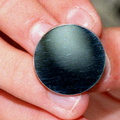
WIKIARCHIVES.SPACE
The Human Spaceflight Archive

Information
- Taken in
- Kennedy Space Center
- Author
- NASA
- Description
- Students Scott Kerley and Bryan Geer demonstrate how they polished mirrors for STARSHINE, a student spacecraft built by the Naval Research Laboratory in Washington, D.C. The two seventh graders at McNair Magnet School, Cocoa Beach, Fla., are among dozens of students teams of elementary, middle and high school students who have polished nearly nine hundred of the one-inch mirrors and returned them to Utah for coating with a protective transparent layer of Silicon Dioxide at Hill Air Force Base. The mirrors are being mounted on the surface of the spacecraft. STARSHINE is being deployed into a highly inclined low-earth orbit from a Hitchhiker canister on mission STS-96, targeted to launch May 20. After deployment from the Shuttle in May, the spacecraft will reflect flashes of sunlight to observers on the earth during the mission. This twinkling satellite will be naked- eye visible against the star background for about six months during recurring morning and evening twilight periods to student observers around the world.
- Created on
- Wednesday 14 April 1999
- Albums
-
Locations / OSM-4.915832801313164
US SPACE PROGRAM / SPACE SHUTTLE / MISSIONS / STS-96 / Rocket preparation
- Source link
- https://science.ksc.nasa.gov/gallery/photos/1999/
- Visits
- 44
- Rating score
- no rate
- Rate this photo
- License
- CC BY-NC-ND
- Modified by WikiArchives
- No (original)
- Downloads
- 0
Powered by Piwigo

